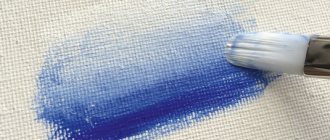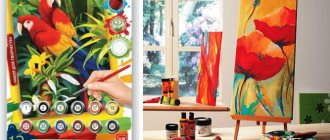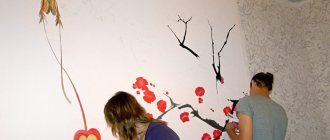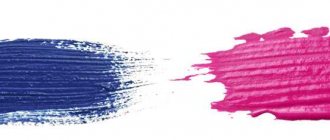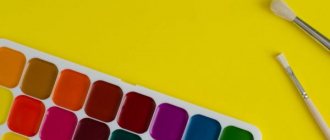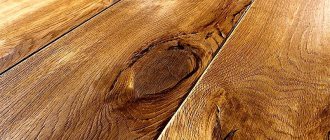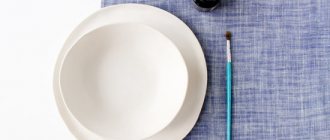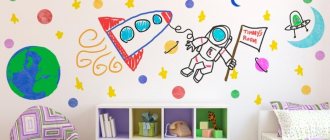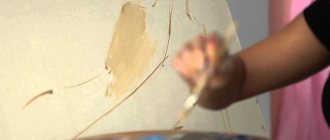Artist's kit - components
To learn to draw, you cannot do without paints. It’s better to buy high-quality paints right away, because too cheap paints adhere worse, and therefore the learning process will be less productive. A beginner should not spend money on a professional set: to start drawing from scratch, all you need is basic colors:
- titanium white;
- yellow (lemon, medium yellow, yellow ocher);
- red (carmine, cadmium);
- blue;
- emerald and light green;
- black.
It is easiest to work with gouache, but an adult or schoolchild can easily cope with watercolor. The ideal option is not an ordinary children's one, but a watercolor for artists, which is of the best quality. Budget sets of 24 colors cost 400-500 rubles. In principle, five tones (red, blue, yellow, white, black) are enough for an artist, and the rest can be created by mixing. To combine paints, you need to immediately buy a palette. The shape and material can be any. There are round, oval, square palettes, wood and plastic products on sale. The size of the palette is also left to the user’s choice.
It is equally important to choose a good brush. For beginners, three brushes of different sizes are enough. You can also additionally buy a thin brush for making dotted drawings and small details. The most popular are squirrel brushes - they absorb water well, release it longer, and therefore paint without spots or streaks. This brush is good for glazing or creating clear contours.
A kolinsky brush – round, with a sharp tip – is also suitable for a novice artist. It is also convenient for working out thin contours and elegant details using the technique of painting with watercolors. The kit must include a flat, wide brush for filling. It is used to create a background or stripes over a large area of canvas or sheet of paper. Over time, fan, linear, and retouching brushes are usually added to the collection of brushes. It is important to inspect the brushes for the reliability of the connection between the bristles and the handle - it should be very strong.
Other accessories in the artist's kit:
- Paper. For watercolor paints, you should buy special paper with low absorption, which will not allow water to wet the sheet before it is completely dry. On plain printer paper, watercolors tend to bleed. The best option is hot-pressed paper; it additionally has a very smooth surface.
- Thinners. Special solvents will be required to dilute oil paints. Typically, linseed oil or turpentine is used for this. It is not recommended to use organic solvents - they spoil the structure of oil paint and remove the beautiful shine. However, to clean paint from brushes you need to buy turpentine and white spirit.
- Canvas. Typically used for painting with oils or acrylics. The stores have ready-made canvases on stretchers made of linen, cotton, and synthetics. Natural fabrics are dense, sag little, and patterns look more beautiful on them. You can also make your own canvas. To do this, you need to buy a stretcher, cover it with fabric, and then prime it. As the primer dries, drag the canvas a little tighter.
- Easel. It is recommended to purchase it if you plan to take up drawing seriously. The easel is placed at eye level, which gives an excellent overview of the painting, helps to work correctly and quickly look for flaws. For small canvases, mini easels are available for sale.
- Protective varnish. It is advisable to coat the painting with varnish, this will help protect it from ultraviolet radiation and make the colors richer.
Also, to create an artist’s kit, you need to buy jars for brushes, wet wipes, and cotton rags. To work with oil, you will need a palette knife - a spatula for thick paint, removing dried material and applying beautiful strokes. It is also worth buying oil cans with clips (single or double) that contain paint and are easily attached to the palette.
Watercolor
Typically, most people begin their creative journey with watercolors. For beginners, this technique seems more accessible since it is a water-soluble paint. Watercolor is a spectacular technique that amazes with its ease.
Agree, when you see watercolor drawings, you want to repeat them. The weightlessness and purity of color captivate you and inspire you to create your own works.
However, despite the fact that watercolor gives such a simple impression, in reality you can encounter a number of difficulties.
It’s not for nothing that many artists call it the most obstinate technique of them all.
Firstly, to achieve such a pure color you need to try very hard. After all, in order for the sheet to “breathe,” you need to treat the paper with care and try to write everything in one go.
Secondly, a lot depends on the quality of the paper. The denser it is, the more multi-layered the color elaboration can be.
How to paint with watercolors correctly? You need to know the basics of color formation and practice a lot. Then you will be able to master watercolor and all the different effects it gives.
Watercolor painting techniques
You need to learn different drawing methods step by step, moving from the easiest to the most complex. At first, most artists use sketching, then they begin to show imagination and create their own masterpieces. It is recommended to start learning to work with watercolors with the techniques described below.
Painting with a flat brush
If the drawing is invented, you should follow these steps step by step:
- Draw a square or rectangle to indicate the beginning and end of the layer. Use a dark shade to draw a thin line from the top left corner to the top right corner.
- Wet the brush with watercolor. Make the second stroke from the bottom edge of the first line, covering the paint that has accumulated below. You need to work quickly to avoid watercolor drips, or carefully wipe them off with a cloth.
- Repeat this action again with the next line. It is better to use the flat edge of the brush for strokes, which will make the bottom of the stroke smoother. Intermittent strokes must be re-drawn immediately.
- Completely fill in the outlined outline, repeating the steps in the same way. It is important to maintain an even tone of paint and not change the brand of watercolor. On paper that is too thick, the strokes may be uneven. Then it is recommended to lightly sprinkle the sheet with water, blot it, let it dry, and only then start drawing.
At the end of the work, you need to rinse the brush, squeeze it dry, and use it to remove all clumps of paint at the bottom of the last stroke, avoiding discoloration of the drawing. To give the picture some texture, you can leave it to dry on an angle.
Gradient
First, you also need to work out a square or rectangle (in the future this will be the drawing required by the artist). Then you should take the following steps:
- dip the brush in a dark shade of the required color, draw a vertical or horizontal stroke;
- wipe the brush with a cloth or paper napkin, dip it in a lighter shade of the same color, draw a stroke overlapping part of the previous one;
- rinse, wipe the brush, make another stroke (lighter, darker or a completely different color);
- repeat until the figure is filled;
- rinse the brush, dry it, pick up the remaining paint.
Using a gradient, you can create very interesting transitions that form the basis of a future painting.
Watercolor glaze
The glaze technique requires the artist’s imagination; with its help, landscapes, images of autumn and summer, and landscapes come out well. Description of the technique using the example of a landscape:
- paint the sky above and the river below using blue watercolors;
- dilute the paint with water, draw a waterfall;
- make pink clouds in the sky;
- decorate the bottom of the picture and the mountain in yellow;
- let all layers dry thoroughly;
- use dark blue to shade the horizon of the mountain and its top, and you can also use it to beautifully decorate a waterfall;
- make the banks of the river orange, shade the sky a little;
- as the drawing dries, draw bubbles on the waterfall in purple;
- you can draw trees along the banks of the river - trunks in brown, leaves in green;
- tint the sky and water blue;
- Draw the grass in blue and green;
- you can depict trees and fruits under them.
The point of glazing is that all layers of paint interact with each other, overlap one another and, when overlapped, give even more interesting effects.
"Wet" technique
Before drawing, you need to moisten a sheet of paper with water. Of course, you need paper that is thick and does not sag. Wetting is done using a sponge, having previously wrung it out. The moisture should be evenly distributed over the sheet and not shiny, otherwise there will be too much water on it.
Next, you can make any drawing on paper, for example, an autumn bouquet:
- first draw the background, choosing any light shade;
- draw a vase;
- draw leaves in a vase using yellow, red, orange;
- Apply each new shade after the previous one has partially dried, the blurriness of the lines creates very interesting effects;
- at the end of the work, you can place accents using brown, dark brown, burgundy, and create shadows;
- Use a wet, clean brush to blur the edges a little, but do not overdo it to avoid the sloppy appearance of the drawing.
You should not combine cold and warm tones in one drawing, this will create visual dissonance.
Dry brush painting
It is not difficult to draw using this technique. You need to take the paint on a dry brush, then make a stroke on paper. It is recommended to first sketch in pencil. At first, the sketches will be quite rough - for example, the outlines of the sky, trunks and branches of trees, a river. After the first layer has dried, details are added, shadows are created, and texture is drawn. Then they create a background around it and place the necessary accents.
When drawing, you need to change the pressure on the brush, which will allow you to add or remove texture. It is important that the brush does not remain too wet after rinsing and blotting. Otherwise, the paint will not give a textured effect and will look flat.
No excess moisture
The technique is well suited for drawing clouds and streams of light. Before you start, you need to prepare several sponges or facial sponges. First, strokes are made with a dry or wet brush, then they are rubbed with sponges. It is important not to rub the sheet too hard to avoid damaging the paper. Highlights can be done with paper towels. Afterwards, if necessary, the contours of the drawings and accents are drawn with a thin dry brush.
Discoloration of dried paint
In this case, the already dried drawing is lightened. The desired areas need to be moistened with a cloth and gently wiped with a dry brush. It's best to use brushes with stiff bristles that can scrape up a bit of the paint. Actions must be careful, otherwise there is a risk of damaging the paper.
Instead of using a cloth, it is permissible to spray the paper with a spray bottle, and then moisten the moisture with a paper towel. Another option is to carefully rub the design with sandpaper, then you do not need to wet it first.
Finger painting classes
The very first paints for the youngest children are finger paints. Why them?
But because from a very early age, children's fingers become the main assistants in exploring the world around them.
And they can work with these tactile instruments, applying artistic material to them.
But there is no format for working with finger paints; children can work with them independently, creating doodle drawings.
However, some features of working with them are still worth noting:
- To work with paints, you need a large canvas, since small children do not feel boundaries and can go beyond them;
- Children need to start drawing only in a good mood, otherwise the little artist may refuse to participate in the creative process;
- In the first lessons, you should pay attention to only one color of paint, for example, on the first day you should introduce yellow, on the second with red, and on the third with a green tint. And only after a while are you allowed to mix colors;
- The first lessons should last no more than 5 minutes, gradually increasing the time of creative play, but not going beyond half an hour;
- Show the kids that you can draw not only dots, but also lines using your fingertips.
And when the child grows up a little, you can begin to move with him from scribbles to such working methods as:
- Finalization of drawn scenes. For example, cars are drawn without wheels and the child’s task is to complete the wheels with their fingers, or vases are drawn without flowers and they need to be completed;
- Finger painting in a stencil – painting with your fingers a stencil picture, for example, animals;
- Palm drawings - use not only the fingertips, but also the entire palm in creating drawings.
You can also start trying to use children's coloring books, and later move on to coloring them with pencils and a brush with watercolors.
Gouache for beginners
It is usually recommended to learn to draw with gouache in childhood - from 4-6 years old. It is very easy to apply, does not float, and is much easier to work with than watercolor. Gouache drawings can be very diverse - nature, animals, flowers and trees, fruits, etc. Adults paint real landscapes with gouache.
You can make drawings not only on paper, but also on canvas, plywood, wood, fabric, even on stones and pebbles. For this purpose, it is better to purchase not children's gouache, but artistic gouache, which is of high quality. First, a pencil sketch is made, then it is painted over. Start with dark colors, gradually moving to light ones. You need to mix paints taking into account the color wheel, otherwise the result will be a gray tone.
Easy watercolor drawings
Watercolor flowers
It’s worth starting, perhaps, with flowers. Watercolor probably exists especially for them.
All multi-layered designs start with the lightest tones. Do not forget!
Lavender, if you want to draw a herbarium in a sketchbook
Try shapes, colors, change brushes, combine techniques. It is very exciting
Landscape in watercolor
Landscape watercolor paintings assume the background of the surrounding world. You will have to learn how to work with it, mix adjacent colors, work out gradients and borders. Practice, for example, here
We have already drawn a pine forest in the previous topic, now the work is more complex and elegant.
Stunningly beautiful watercolor drawing, very neat sunset gradient
Another very interesting work in landscape style
Another simple, but noteworthy watercolor work.
Landscape watercolor paintings with very fine layered work
Features of oil paints
Experienced artists greatly value oil paints, which are available in a wide range in specialized stores. The paints contain minerals, organic and synthetic components. They are diluted not with water, but with linseed oil, which gives brightness and richness of tone. Paints take a long time to dry, but the design can be adjusted over a period of time. To dilute dried, thickened paint, a special oil is also used, which is sold in art departments.
Types of oil paints
There are three types of oil paints:
- Highly artistic. They are usually used for professional painting. The price of the material is high due to the excellent quality of the components. For decades, paints do not lose color or fade.
- Sketchy. Suitable for beginners, inexpensive, can be used in different techniques.
- Studio. They have an intermediate price between the two listed options and are suitable for artists and beginners.
Oil paints can also be transparent or opaque. The latter are denser and do not allow light to pass through. If the packaging is o, such material is very durable and lasts a long time. The more stars, the higher the quality of the paint.
Rules and techniques of drawing
The oil painting looks very beautiful. Each stroke looks on its own, although achieving such an effect is quite difficult. There are two main techniques: one coating (alla prima) and several layers. To apply multi-layer paints, you will have to try - work quickly, do not dilute the material, know its properties and how one tone will look on top of the second. Oil consumption for multi-layer application is usually large.
A single-layer pattern has its disadvantages. So, over time, brushstrokes can crack due to paint shrinking, so most professionals dry the first coat and apply at least one more. This way material costs can be reduced.
Recommendations when working with oil:
- the lighting must be good, otherwise there is a risk of creating unnecessary shadows in the drawing;
- First you need to draw a contour, then apply oil strokes along the lines;
- colors can be mixed, knowing the basic principles of combining tones;
- Usually they paint pictures starting with bright elements, highlighting the darkest and lightest points;
- after completing the sketch, outline the contours and details, make the necessary accents;
- the finished painting should be allowed to dry for three days, but on the second day you can make some edits;
- After drying, the canvas should not be rubbed or touched with hands.
Watercolor drawings with examples
Drawing a rose in watercolors
Let's look at watercolor drawings of flowers. Rose, for example. We learned how to draw a rose in a recent lesson, take a look for examples
First, draw a light, barely noticeable sketch with a pencil.
Using the simple overlay technique, first apply all the light colors, cover them after complete drying again with the same color, or darker
If in an area where there should be a light part. Carefully remove the paint from the layer with a thin brush.
We continue to apply watercolors to the drawing. Light colors on the stem, leaving unpainted areas on the leaves for future highlights and shades
We finish the drawing with dark colors, finalize the edges and wait until it dries completely to remove pencil marks
Watercolor drawing of peony
The most common flowers in watercolor paintings are lilacs, and perhaps peonies. Let's try to draw a peony.
As in the first example, first a light sketch
The technique is no different, including in the order of tones - light first.
Add shadows to the leaves and prepare a base for the pink color of the petals, covering it with a very light pink shade
A darker pink shade gives us a sense of depth in the design, indicates shadows inside the petals, and enlivens the design.
This could have been completed by finishing the middle, but it can be combined with the wet drawing technique by adding lush foliage to the background of the drawing.
Before doing this, dry the drawing. Using a slightly damp wide brush, go over the background, and with a semi-dry brush and paint, apply sprigs of greenery and small pink flowers. Finish the core of the flower. Dry the canvas.
At the final stage, refine the foliage stems and small multi-colored flowers in the background.
How to paint with acrylic correctly: tips for beginners
Acrylic paints combine the properties of oil and watercolor; they do not fade and are not afraid of water. You can apply layers directly on top of the previous ones without waiting for them to dry. To begin with, it is better to buy a set of 6 colors, then expand to 18. You should paint with acrylic on paper, canvas, fabric, glass, plastic, stones. Dilute the paint with water and solvents. The following techniques are used:
- dry – on paper, canvas;
- wet - on a dampened canvas;
- glazing - applying a thick layer and then shading it;
- impasto - painting with clearly distinguishable strokes.
To give the drawing a complete look, you can apply individual strokes with felt-tip pens, markers, pencils, and pastels. First they do simple pictures, then they move on to still lifes, views from the window, and portraits. For learning, it will be useful to use the abstraction technique - making spots and adding details, giving them an image.
Tips for working with acrylic are:
- You should have a spray of water nearby to wet the quick-drying paints;
- by adding water, you can make a more transparent material from acrylic paint;
- Do not add too much water; after drying, the paint may crumble;
- Before wetting the brush in paint, you need to dry it;
- adding a solvent rather than water will help slow down the drying of the material;
- To preserve the design, it is coated with varnish.
Drawings on fabric
It is quite difficult to make fabric drawings; it is better to practice on a different basis. If you have experience, it is quite possible to paint on silk, synthetics, and natural fabrics. First, the fabric needs to be washed, ironed, stretched over a frame or placed on a flat base. Place oilcloth under the fabric and make a drawing with a special felt-tip pen for fabric. Then do artistic painting. The easiest way is to work using ready-made stencils, but you can make a drawing yourself. After a day of drying, you need to iron the product, after 2 days it can be washed.
Paintings on canvas
For acrylic, canvas is the ideal base. The paints must be prepared in advance and diluted with water. If mixing is planned, it is better to use a special solvent, otherwise the material will dry out quickly. The palette should be periodically sprayed with water. They begin to draw the largest details, and as they draw smaller lines, change the brushes to thin ones. The norm for diluting paints with water to create more transparent tones is less than 20%.
Drawings on paper
It’s worth trying drawing on paper for the first time. Since the structure of the paints is dense (it is, in fact, liquid plastic), ordinary thin paper will not work. It is better to take cardboard or special thick paper. Drawings can also be done on paper wallpaper that is already pasted on the walls. This is a popular design technique that allows you to decorate a plain material and give the room an original look.
Glass painting
Pictures on glass look very beautiful, reminiscent of finished stained glass. The outlines of the future drawing are made with a thin marker according to the sketch, which is placed under the glass. Afterwards, paint is applied in layers, forming the desired color combinations, accents, lighter and darker areas. At the end of the work, acrylic varnish is applied to the painting.
Colors give endless scope for imagination. Learning to draw is not difficult. Even without talent, you can make beautiful drawings with enough diligence and perseverance.
Gouache
The main difference between gouache and watercolor is its density. If in watercolor it is quite difficult to correct a mistake, then in gouache things are different. This material is very flexible. You can easily correct a bad area of work as soon as the previous layer has dried. For many, this difference is key in choosing a material.
But it is worth noting that gouache has one feature. When it dries, it moves out. A certain whitish coating appears on the work, which noticeably changes the color saturation of the work.
This water-soluble technique is suitable for beginners, primarily because it is very flexible. Gouache is the easiest material of all to master.
You can even paint gouache on the window, because it washes off easily. With a little imagination, you can decorate your windows with bright designs during the holidays. Of course, there are special stained glass paints for these purposes, but this technique requires separate consideration.
Effects and other techniques
Whatever material you choose, remember that practice is key. To feel all the possibilities of paints, you need to paint several works and compare them. If you see progress, then you are on the right track. Try experimenting and applying different effects.
Try working in mixed media. Take watercolors and pencils. Try to express your emotions in relation to the object that you are depicting.
From sketches during a trip to Peru
For example, I really like mixing watercolors and all kinds of crayons and pencils.
Mixed media works always look impressive and unusual.
Z. I. Serebryakova “Behind the toilet.
Self-portrait" How to paint beautifully? Draw things that interest you and practice as much as possible. You will be able to depict people and clothes without any problems.
Just make sketches before you start creating a larger piece.
If you are interested in drawing a portrait, then first familiarize yourself with the proportions and basic rules for depicting a face.
It is important not to be afraid and draw. Just as children paint without fear, adults should also approach the creative process. But we are always afraid of spoiling.
Get inspired and bring your ideas to paper or canvas. You will definitely succeed!
Drawing Ideas
What can you draw on a free theme:
- pet;
- portraits of family members from life or from photographs;
- cityscape;
- the underwater world and its inhabitants;
- fairy-tale animals, such as J. K. Rowling's Fantastic Beasts;
- favorite book or movie characters;
- indoor flower;
- culinary dish.
An inexhaustible source of ideas for drawings are dreams.
